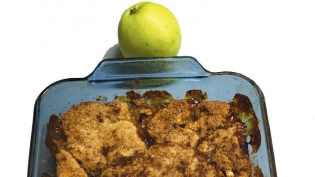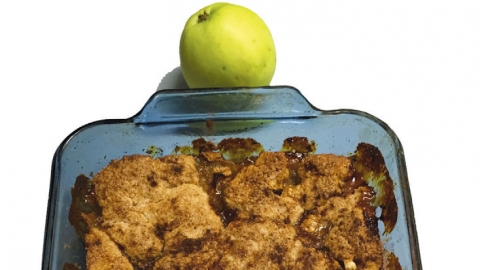Core Curriculum
There is no tree more beautiful than an apple tree in bloom, with its pink and white petals floating down in spring. In early May the buds on New England’s apple trees begin to grow, and soon, five-blossom clusters emerge. In the center of each cluster appears the largest blossom called the ‘king” blossom. This is the signal to begin pollination.
For most apple trees cross-pollination is critical, and pollen from more than one apple tree is needed for good fertilization. Apples require crosspollination between individual trees by insects, typically bees, which freely visit the flowers for both nectar and pollen. For this crosspollination, thousands of bees must visit trees to ensure a good crop. At large orchards, hives are hired and brought in by apiaries to supplement the wild native bees and bumble bees. This past year in New England it was a good year for wild bee numbers, but still more bees are necessary for a uniform, commercial crop.
Some of the contracted honey bees travel around the country pollinating seasonal crops throughout the year. Many beehives are brought to the southern states for various crops, then to California for almonds, on to New Jersey, New York and New England for apples, then Maine for blueberries, and the Cape for cranberries.
When the English colonists arrived in North America they found only crab apples. Crab apple trees are the only apples native to the United States. They are quite small and very sour and made a good jelly or hard cider, but were not good for fresh eating. As more settlers arrived they brought their favorite apple cultivars, but those early orchards produced very few apples. The lack of honey bees in America was the problem. There were none in America until the white settlers brought hives from Europe.
Historical information indicates that colonies of honey bees were shipped from England and landed in the Colony of Virginia early in 1622. One or more shipments were made to Massachusetts between 1630 and 1633, and others between 1633 and 1638. The Indians called the honey bees “English flies” and a description of the settlements in 1670 claimed that “You shall scarce see a house but the south side is begirt with hives of bees.”
By the 1640s, orchards were well established and nearly all land owners planted apple trees. Many old homesteads still have the remnants of small home orchards today.
Until recently the domestication of the wild apple was only theorized. The discovery in the last decade of the apple’s wild ancestry is big news in the apple world. With the use of molecular genetic markers capable of distinguishing between species, and explicit methods of phylogeny reconstruction (the history of the evolution of a species or group) it is now possible to test theories about the origin of the domesticated apple, and what researchers have found is astounding.
Although you’ve probably never heard of him, the Russian scientist Nikolai Ivanovich Vavilov may be one of the greatest contributors to seed saving in the history of the world. A geneticist, breeder and biologist, Vavilov is perhaps best known for having identified the centers of origin of many cultivated plants. While developing his theory, Vavilov organized a series of botanical expeditions, and collected seeds from every corner of the globe.
Vavilov had suggested that the wild apples of Turkestan (Kazakhstan, Kyrgyzstan, Uzbekistan, Turkmenistan and Tajikistan) were the progenitors of the domesticated apple. “All around the city one could see a vast expanse of wild apples covering the foothills,” he wrote. “One could see with his own eyes that this beautiful site was the origin of the cultivated apple.”
Vavilov reasoned that, because the wild apple bears similar fruits to the domesticated apple, it must have been the progenitor. Vavilov’s oversimplified idea that the center of diversity of the apple is its place of origin has been partially confirmed in recent field work and it is generally accepted that the first apple trees to produce sweet, flavorful apples similar to those we enjoy today were located many thousands of years ago near the modern city of Alma-Ata, Kazakhstan. Its name is Malvus sieversii, the Central Asian wild apple. Malvus sieversii is considered a population rather than a cultivar because there is considerable variation in height, shape and fruit in these trees.
Unfortunately for both botanists and Vavilov himself, his discovery was lost to science when he was jailed in Russia in 1941 and sentenced to death by Stalin for his views on genetics. He died of starvation in 1943.
Years passed until the rediscovery of Vavilov’s findings was recently revealed. One of his last surviving students, Aimak Djangaliev, invited American scientists to Kazakhstan to witness the great stands of wild apples that he had been studying since Soviet rule. Djangaliev was 80 years old at the time. He was seeking their help in saving the great tracts of M. sieversii as human development encroached and forests were being cut down. It is estimated that 75% of the original forest has already been degraded or destroyed.
The American scientists were in disbelief when they visited Kazakhstan. Wild apples were so prolific that they were even growing through the cracks in the main streets of the surrounding towns. The immense wild stands of 300-year-old trees were astounding, some 50 feet in height, with the girth of an ancient elm. Never pruned, irrigated or fertilized, what was left of this immense forest of apple trees was thriving, loaded with apples of all kinds. As the scientists observed and collected these wild apples, they found hugely diverse ranges of colors, sizes and flavors, not unlike those of our modern day apples: a forest of rich genetic diversity. The belief that our apples evolved from tiny, sour, misshaped crab apples was now put to rest. With the aid of modern genetic technology, molecular variation within this wild apple indicates that the earliest selections of domesticated apples may have come directly from this wild apple.
The story of the wild apples is a long and winding journey. As long as ten million years ago, mammals such as bears began distributing apple seeds, passing them through their digestive system along their migration routes, selecting the largest and sweetest fruits from the Kazakhstan forests. Some apples even passed whole and undigested through their gut and were redistributed miles away. Apple seeds retained in the apple core do not germinate, which was certainly convenient for their long journey.
Next, some 5000 to 8000 years ago, humans began to travel through these areas and, assisted by the now-domesticated horse, the evolution of the apple was almost complete. The Silk Road passed through Kazakhstan, and perhaps Marco Polo even had a few apple seeds in his pockets or saddlebags or even his horse’s stomach on the way home.
Over the next few thousand years, and from within this migrating flow, came the many thousands of apple cultivars now known through the result of both unconscious and conscious selection. M. sieversii probably hybridized with at least two species of tiny, green sour apples along the way, M. orientalis and M. sylvestris.
Grafting, described as “instant domestication”, where a certain variety or “cultivar” can be preserved forever, was believed to be in practice in Mesopotamia as early as 3800 years ago. From there the apple and grafting skills passed through the Persians and Greeks to the Romans, who perfected it. The Romans brought their knowledge to Western Europe and, for the last 2000 years, the domesticated apple has diversified and flourished around the world.
Most of the now great American apple varieties were chance seedlings found in cider orchards in the eighteenth and nineteenth centuries. Since American colonists’ favorite use of the apple was for making hard cider, they didn’t bother much with grafts, planting apples instead from seed. Because of the variations of apple genetics, most seedling trees produce inedible fruit, good for little but cider, so it all worked out. Cider pressing in America is a tradition that dates back to the 1620s, less than a decade after the Mayflower landed at Plymouth Rock. For more than two centuries, nearly all New Englanders drank cider, and lots of it. To cite just one example, Middlesex County, Massachusetts, produced 33,436 barrels of cider in 1764, or seven per family, well over a barrel for every man, woman, and child.
Later, Johnny Appleseed, along with settlers migrating west, planted apple seeds with wild abandon and some of those plantings yielded exceptional varieties by chance that are now considered favorite American cultivars.
With a fruit of such historical importance, whose arrival to this world closely coincides in age with that of man’s arrival on the planet, one wonders how it ever made it with the plethora of diseases, insects and fungi that afflict it today: fireblight, apple scab, rust, powdery mildew, codling moth, apple maggot, spider mites, scale and aphids, to name just a few. Well apparently, with the discovery of M. sieversii, that wasn’t always the case and man’s intervention is to blame. Much like the elm trees so extensively planted and now stricken down by disease to almost extinction, the apple is now in the same predicament.
In nature a plant coevolves, eventually triumphing over its enemies. It’s always a game of catch up as the insects continue to evolve themselves, but in the end the strong survive in the name of procreation. But with named cultivars, clones of the parent through cuttings, the apple tree becomes a sitting duck for failure, frozen in evolutionary time. The genetic makeup of these wild trees of Kazakhstan may hold the key to saving the apple from the barrage of fungicides and pesticides needed to grow a flawless apple. Saving the great tracts of Malva sieversii could be essential for the evolutionary success of the many named cultivars of apples that we are familiar with today, and the key to creating new, disease-resistant cultivars that will certainly appear from the reintroduction of the wild apple’s genes in breeding programs.
Apples are a bit like fine wine; they can have good and bad “flavor” years. Many apples ripen with age, and a month in a sealed bag helps many varieties to attain a more complex flavor and texture. Others don’t. Some are best eaten fresh; some are best in a pie. Windfalls are great for cider, crab apples for jam.
The long winter and cool spring this past year might have been frustrating to many New Englanders, but it was good news for the apple tree. This July, to my surprise, one of our apple trees, a cultivar named Lodi, rained down a windfall of nearly perfect, ripe apples. This tree, which I have never sprayed or even pruned, had never before given an edible apple. This year we filled bushel baskets. Lodi is a very early maturing apple with a sharp taste best used for cooking. It is best eaten soon after harvest, so we started making apple cobblers. I used an old peach cobbler recipe, changing it up a bit for apples, and it turned out as good as it gets. Enjoy!
Veronica Worthington is an organic farmer who grows heirloom vegetables for market and breeds heritage sheep for wool in West Dennis.







